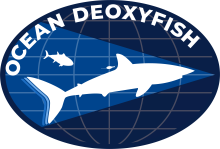OCEAN DEOXYFISH: Ocean deoxygenation effects on threatened top predators: New understanding and predictions from novel bio-logging instruments and data
Climate-driven reductions in dissolved oxygen (DO) of the global ocean interior (ocean deoxygenation) is leading to expansion of permanent oxygen minimum zones (OMZ) that comprise about 7% of ocean volume. But predictions of how exploited oceanic fish actually respond to OMZ expansions are not based on mechanistic understandings, principally because direct measurements of oxygen tolerances and associated metabolic costs have not been determined.
OCEAN DEOXYFISH is developing new biologging technologies and in situ physiology for measuring oxygen tolerances and metabolism directly in free-living fish. This will enable major unknowns to be addressed concerning how oceanic fish respond physiologically and behaviourally to hypoxic water, the role of OMZs in upper-trophic-level ecology, how oceanic fish habitats change with predicted OMZ expansion, and whether this will increase fish vulnerability to fishing gear.
Objectives are achieved through linked field, experimental and modelling studies. By focusing on key processes underlying fish responses to DO in situ, new modelling approaches are establishing effects of future warming and OMZ shoaling on fish niches and determining how these shift distributions and alter capture risk by fisheries. The project represents a discipline-spanning approach linking physiology to ecology and oceanography, with wide-ranging outcomes for understanding global biotic responses to warming and ocean deoxygenation with direct relevance to sustainable fisheries and species conservation.
OCEAN DEOXYFISH is funded through a European Research Council (ERC) Advanced Grant
Recent project publication:
Vedor, M., Queiroz, N., Mucientes, G., Couto, A., da Costa, I., dos Santos, A.M., Vandeperre, F., Afonso, P., Fontes, J., Rosa, R., Humphries, N.E., Sims, D.W. (2021) Climate-driven deoxygenation elevates fishing vulnerability for the ocean’s widest ranging shark. eLife 10, e62508. https://elifesciences.org/articles/62508
